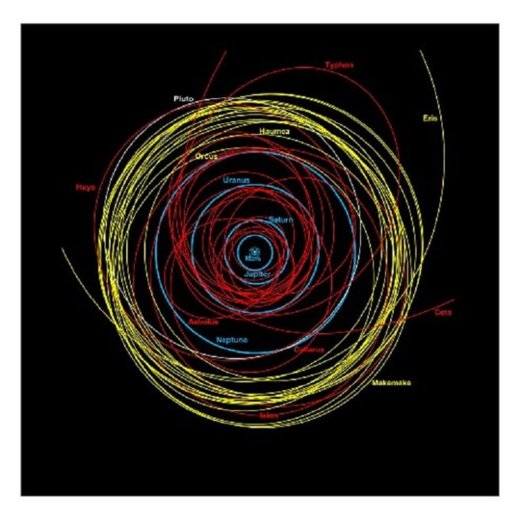
© The Daily Galaxy
A decade ago, Stephen Hawking warned that one of the major factors in the possible scarcity of intelligent life in our galaxy is the high probability of an asteroid or comet colliding with inhabited planets.
This past December, a team of astronomers from Armagh Observatory and the University of Buckingham reported that the discovery of hundreds of giant comets in the outer planetary system over the last two decades means that these objects pose a much greater hazard to life than asteroids.Giant comets, termed centaurs, move on unstable orbits crossing the paths of the massive outer planets Jupiter, Saturn, Uranus and Neptune. The planetary gravitational fields can occasionally deflect these objects in towards the Earth.
Centaurs are typically 50 to 100 kilometer across, or larger, and a single such body contains more mass than the entire population of Earth-crossing asteroids found to date.
Because they are so distant from the Earth, Centaurs appear as pinpricks of light in even the largest telescopes. Saturn's 200-km moon Phoebe, depicted in this image, seems likely to be a Centaur that was captured by that planet's gravity at some time in the past. Until spacecraft are sent to visit other Centaurs, our best idea of what they look like comes from images like this one, obtained by the Cassini space probe orbiting Saturn. NASA's New Horizons spacecraft, having flown past Pluto six months ago, has been targeted to conduct an approach to a 45-km wide trans-Neptunian object at the end of 2018.
Calculations of the rate at which centaurs enter the inner solar system indicate that one will be deflected onto a path crossing the Earth's orbit about once every 40,000 to 100,000 years. Whilst in near-Earth space they are expected to disintegrate into dust and larger fragments, flooding the inner solar system with cometary debris and making impacts on our planet inevitable.
Known severe upsets of the terrestrial environment and interruptions in the progress of ancient civilisations, together with our growing knowledge of interplanetary matter in near-Earth space, indicate the arrival of a centaur around 30,000 years ago. This giant comet would have strewn the inner planetary system with debris ranging in size from dust all the way up to lumps several kilometres across.
Specific episodes of environmental upheaval around 10,800 BCE and 2,300 BCE, identified by geologists and palaeontologists, are also consistent with this new understanding of cometary populations. Some of the greatest mass extinctions in the distant past, for example the death of the dinosaurs 65 million years ago, may similarly be associated with this giant comet hypothesis.

© The Daily Galaxy
The researchers have also uncovered evidence from disparate fields of science in support of their model. For example, the ages of the sub-millimeter craters identified in lunar rocks returned in the Apollo program are almost all younger than 30,000 years, indicating a vast enhancement in the amount of dust in the inner Solar system since then.
The outer solar system as we now recognise it. (see image, right) At the centre of the map is the Sun, and close to it the tiny orbits of the terrestrial planets (Mercury, Venus, Earth and Mars). Moving outwards and shown in bright blue are the near-circular paths of the giant planets: Jupiter, Saturn, Uranus and Neptune. The orbit of Pluto is shown in white. Staying perpetually beyond Neptune are the trans-Neptunian objects (
TNOs), in yellow: seventeen TNO orbits are shown here, with the total discovered population at present being over 1,500. Shown in red are the orbits of 22 Centaurs (out of about 400 known objects), and these are essentially giant comets (most are 50-100 km in size, but some are several hundred km in diameter).
Because the Centaurs cross the paths of the major planets, their orbits are unstable: some will eventually be ejected from the solar system, but others will be thrown onto trajectories bringing them inwards, therefore posing a danger to civilization and life on Earth.
Following its historic first-ever flyby of Pluto, NASA's New Horizons mission received the green light in July to fly onward to an object deeper in the Kuiper Belt, known as 2014 MU69. The spacecraft's planned rendezvous with the ancient object - considered one of the early building blocks of the solar system -- is Jan. 1, 2019.
"The New Horizons mission to Pluto exceeded our expectations and even today the data from the spacecraft continue to surprise," said NASA's Director of Planetary Science Jim Green. "We're excited to continue onward into the dark depths of the outer solar system to a science target that wasn't even discovered when the spacecraft launched."
Reader Comments
to our Newsletter